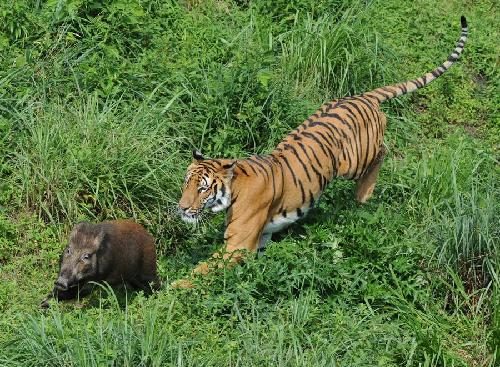
A South China tiger chases a boar in Meihua Mountain Nature Reserve near Longyan city in Southeast China's Fujian province June 10, 2014. (Photo/Xinhua)
Despite an enlarged population in recent years, the South China tiger, an endangered species, still faces an uncertain future.
The number of South China tigers has increased to 165 from 109 in 2014, and all of them live in captivity, said Yin Yu, the deputy curator of Chongqing Zoo in Southwest China's Chongqing on Nov 30.
The zoo is the only one in China that keeps pedigree information of the tiger, an endemic species to China mainly living south of the Yangtze River.
Yin said there is no verifiable evidence for the existence of South China tigers in the wild over the past four decades, according to their pedigree records. He said all the extant captive-bred tigers are descended from six wild ancestors, and they live in 16 zoos and breeding bases across the country.
In the 1950s, the population of the South China tiger was estimated at over 4,000. But large-scale tiger eradication campaigns combined with extensive habitat loss reduced the population considerably in the next few decades.
It was not until 1979 that the tiger was listed as a state-protected animal.
A joint survey made by the former National Forestry Department — now known as the State Forestry Administration — and World Wildlife Fund in the early 1990s found only an estimated 20 to 30 South China tigers remained in the wild in four the provinces of Hunan, Jiangxi, Guangdong and Fujian.
By 2001, a one-year survey jointly carried out by China and the US discovered no evidence for the tiger's existence in the wild.
Due to the extinction of wild tigers, mating can only take place among the captive-bred individuals, which led to inbreeding.


















































